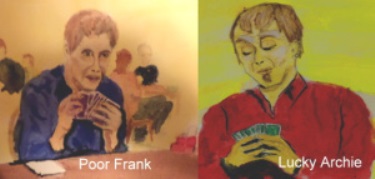Source: raysbridgeblog.wordpress.com by Ray Adams ![]()
![]()
![]()
![]()
Poor Frank was playing a hot game of bridge the other night at his local duplicate club. His chances of finishing first were excellent there was one substantial obstacle in his path. This was Poor Frank’s chief rival, Ian Archibald, generally known as “Lucky Archie.”
It all came down to the following exciting hand:
Dealer South Vulnerable none
Poor Frank reached 6![]() on the sequence shown above. East led the
on the sequence shown above. East led the ![]() A, then switched to a trump when he saw Poor Frank’s queen fall. Declarer won in hand and led a spade to the queen. He ruffed a club high and returned to dummy via the
A, then switched to a trump when he saw Poor Frank’s queen fall. Declarer won in hand and led a spade to the queen. He ruffed a club high and returned to dummy via the ![]() K. He then ruffed another club high. Poor Frank led his last diamond to dummy and ran trumps, sluffing two hearts while picking up East’s remaining trumps. He cashed the
K. He then ruffed another club high. Poor Frank led his last diamond to dummy and ran trumps, sluffing two hearts while picking up East’s remaining trumps. He cashed the ![]() K, then led a heart to his high hand of the
K, then led a heart to his high hand of the ![]() A and the ace and jack of spades.
A and the ace and jack of spades.
The good bidding and nice dummy reversal made it appear that Poor Frank would win that evening’s laurels. Unfortunately, when Lucky Archie was declarer, he lived up to his name. In a bidding sequence too gruesome to appear in print, Lucky Archie arrived in a 6NT contract when he held the South cards. West led the ![]() J, and East, thinking that Archie held the
J, and East, thinking that Archie held the ![]() A and
A and ![]() Q for his bid, signaled encouragement with the nine. Lucky Archie won his singleton queen. When he later played East for the
Q for his bid, signaled encouragement with the nine. Lucky Archie won his singleton queen. When he later played East for the ![]() Q, he came to a total of 13 tricks. This allowed Archie to beat Frank by one point and finish first that evening. Poor Frank was not consoled by all the local bridge buffs who told him he deserved to finish first. Instead he wondered just exactly what he had to do to beat his rival.
Q, he came to a total of 13 tricks. This allowed Archie to beat Frank by one point and finish first that evening. Poor Frank was not consoled by all the local bridge buffs who told him he deserved to finish first. Instead he wondered just exactly what he had to do to beat his rival.
